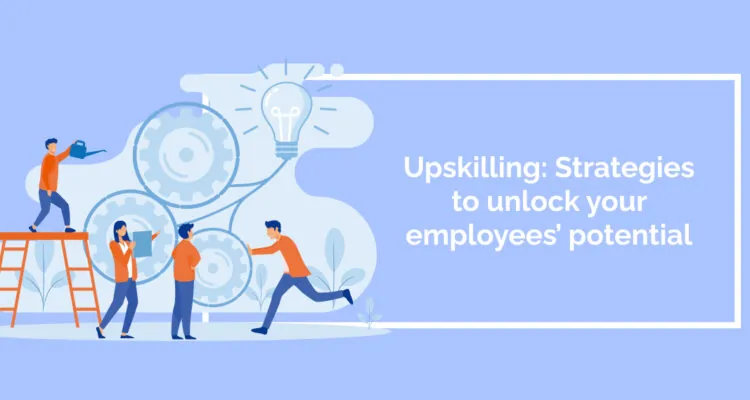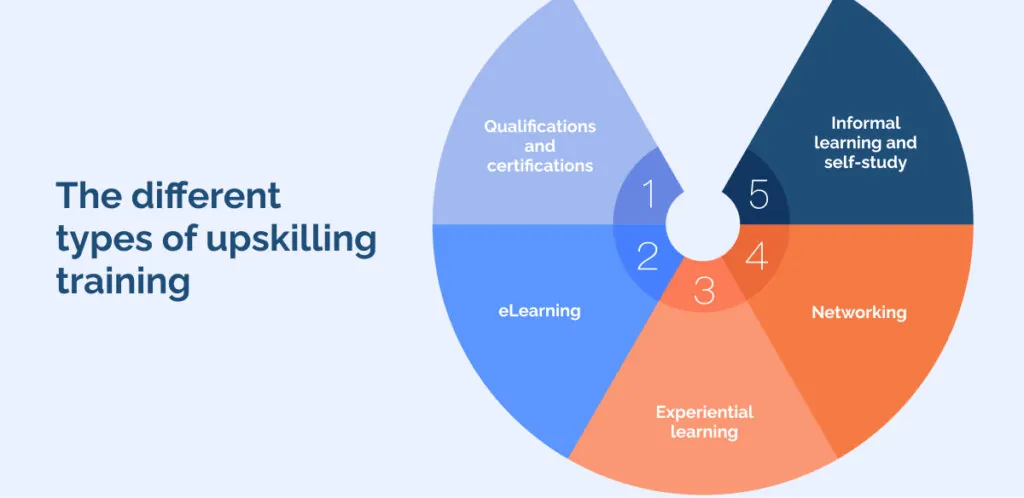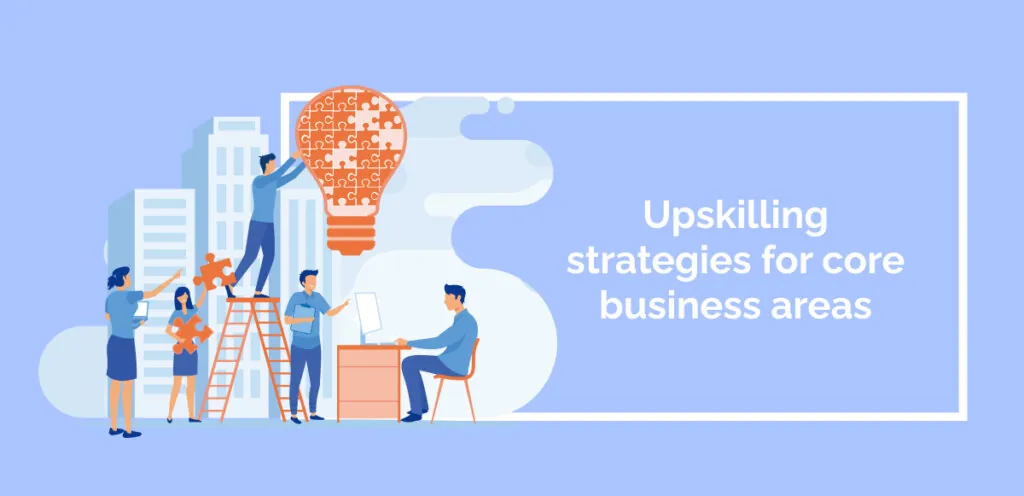
“Upskilling” has become an important concept because of the widespread “skills gap”. Across every sector, HR departments are struggling to hire staff in high-demand and emerging areas.
Upskilling programs support HR by giving staff the targeted training they need for the challenges of tomorrow. It sits with other training programs to create career development, improved leadership, and overall business agility.
In this article, we will:
- Explain the meaning of the word “upskilling”;
- Introduce some of the most valuable methods for upskilling employees:
- Evaluate some of the key circumstances today where upskilling can make an impact.
Upskilling is not new. But as McKinsey’s analysis of the “future work” suggests, it’s now happening more quickly and urgently than ever before. As such, upskilling plays a vital role in your company’s learning culture.
What is upskilling?
Upskilling refers to the process of learning new skills or acquiring additional qualifications to enhance one’s existing knowledge and abilities. The term is often used in the context of professional development and career advancement. Upskilling can involve acquiring new technical skills, improving existing ones, or gaining knowledge in areas that are relevant to one’s current or future job. This training method is usually aimed for existing staff. But it enables HR to hire staff with “adjacent skills” and “stepping-stone skills” skills, as a Gartner report calls them, to solve their skills gaps.
Not all training is “upskilling”. Even though all staff will be exposed to training in their work, they only go through “upskilling” when they are expanding their capabilities. After all, courses for onboarding, compliance training, or safety training simply give staff the tools they need to do their jobs. By contrast, training to become a leader in compliance could be “upskilling”.
Likewise, reskilling and upskilling are not identical terms. Reskilling involves learning an entirely new set of skills to transition into a different job role or industry. It involves a more significant shift in the individual’s career path, often forced by changes in the job market or industry.
What are the different types of upskilling training?

There are many ways of delivering upskilling programs across a large company or organization. In this section, we will look at some of the most important methods for upskilling, including:
- Qualifications and certifications
- eLearning
- Experiential learning
- Networking
- Informal learning and self-study
Learning interventions in all these forms can help make your staff more capable in the present, and ready for whatever the future throws at them.
Qualifications and certifications
Qualifications and certifications play a pivotal role in advancing one’s professional and academic journey. can range from academic achievements, such as diplomas or master’s degree courses, to professional certifications tailored to enhance specific business skills.
For learners, there are many advantages. A clear certificate not only validates their expertise but also opens avenues for career progression within the same organization or even across departments. The flexibility of these qualifications allows individuals to seamlessly transition to new roles or departments, thereby contributing to their overall career development.
While traditional methods of studying for certifications are still prevalent. However, many participants will likely study through eLearning techniques (which will be discussed next).
eLearning
Employees with full-time jobs need flexibility to help them learn new skills. The amazing resources of eLearning are a great way to enable staff upskilling in between their day-to-day working responsibilities.
eLearning allows for customized training content, based on individual needs and the company’s business goals. eLearning emerges as a powerful tool in the upskilling process, enhancing accessibility, engagement, and effectiveness in employee development.
Experiential learning
For complex company-specific tasks, finding the right kind of training can be challenging. One of the best solutions is to train staff on the job, through collaborative training, job rotation, and apprenticeships.
Although this may not feel so efficient, as Markus Hammer pointed out in 2022, “learning at the side of an expert is the oldest capability-building approach of all.” When you trust all your staff to be trainers, amazing things can happen!
Networking
If employees are relying on the knowledge they learned years ago, networking could be one way to engage them in continual cycles of upskilling. Through interactions with peers, mentors, and experts, employees can gain insights into diverse perspectives, acquire new skills, and identify growth opportunities.
Networking events, conferences, and online communities provide platforms for continuous learning, enabling employees to expand their skill sets, build a robust professional support system, and adapt to a changing professional landscape.
Informal learning through self-study
In some professions, the ongoing development of skills and knowledge through self-study is common practice, independent of formal workplace structures.
Indeed, it’s increasingly convenient for employees to engage in informal learning processes at no additional cost. Podcasts, social media, newsletters, and dedicated reading, can give employees useful insights into current issues in their fields.
As this kind of study does not result in a formal certification, managers need to discover and recognize this type of independent learning behavior.
Upskilling strategies for core business areas

Upskilling will change from year to year, from industry to industry, and from business to business.
However, new technologies, demographic changes, and the forces of history all create common skills gaps. This section will explain how upskilling supports improvement in the following areas:
- Technology and software adoption
- Generative AI
- Conflict resolution
- Sustainability
While technology adoption has been a perennial concern for many years, the other three are identified as key trends for 2024 by Gartner analysis.
Technology and software adoption
Software implementation is the process through which staff use new technologies effectively. Given the widespread IT talent shortage, companies need to enable internal staff to understand new digital tools and adapt them to niche departmental purposes.
Software vendors will always boast about the potential ROI of their products on business operations. But without the staff to foster and support the implementation stage, your software may end up being a costly mistake.
By upskilling in technology adoption, individuals contribute to streamlined operations, improved decision-making processes, and the overall innovation capacity of their organization, fostering resilience and adaptability in an increasingly digital landscape.
How to implement technology and software adoption
In introduce upskilling in this area, think about the following steps:
- Upskilling in this area is especially useful when you want to create leaders and champions for new software. Your upskilled technological leaders can help set the tone for organization-wide mandatory training, through seminars, digital adoption platforms, and guided help.
- Emphasize the practical applications of training. How can upskilled employees help to improve workflows, fix problems, and make the software run effectively?
- Methods-wise, informal learning may be one of the greatest assets here. If you’ve got staff who are excited about new technology, make sure they’re rewarded through formal recognition of their upskilling progress.
Who’s it for?
In the case of organization-wide digital transformation, every staff member will need training in new software and techniques. This may mean that upskilling becomes the norm.
However, it is especially useful for people in leadership positions, training managers, and anyone stepping into new roles for tech.
Generative AI
After the wild fearmongering of 2023, generative AI still hasn’t gone away. Although many people still fear for their jobs, smart professionals recognize that generative AI can enhance individual capabilities.
AI’s new importance places several crucial challenges on HR, recruitment, and training:
- Hiring staff with a proven track record in AI is tough. There is no ecosystem of certifications – and we’ve probably learned to be suspicious of people with “prompt engineering” in their LinkedIn bios!
- The industry-specific capabilities of generative AI are still emerging – there is no consensus on what the best use cases are.
- Playing around with unauthorized shadow AI applications can be risky for your company.
For all these reasons, upskilling your existing staff is a trustworthy method of expanding AI capabilities and handling the challenges of AI change management.
How to implement upskilling for generative AI
To embrace the possibilities of AI for the future of work, think about the following steps:
- Focus your efforts on staff who are already in a position to make a difference. Product managers, software developers, and data analysts may already be attuned to the possibilities of generative AI in your niche.
- Although generative AI is the most important aspect of Artificial Intelligence today, don’t forget that there are many other AI models out there. Their impact on your workflows may be subtler than the ostentatious feats of OpenAI’s chatbots.
- Although external providers may offer many promising offers, building an internal training and certification program may be the best way to maximize your investments. McKinsey’s internal program for AI champions has illustrated how important this is.
Sustainability
Sustainability is a rapidly evolving field. There is a growing awareness of the need for organizations to embrace sustainable practices. For some companies, that means a complete overhaul of their business model. And for others, it will mean re-tendering vendor relationships for the lowest impact solutions, with all the rigorous reporting that goes with it.
Across the board, staff members need better training to navigate the intricacies of sustainable practices, stay updated on evolving standards and regulations, and understand the broader implications of their decisions on the environment and society.
How to upskill employees for sustainability
- In terms of methods, simulation training is one of the most valuable ways to train leaders for the challenges of sustainability-informed management. After all, decision-making for sustainability means choosing a different set of priorities. Anyone trained in older methods needs to re-learn their most basic skills.
- There are now plenty of qualifications and certifications in niche aspects of sustainability. Whether that’s product design, marketing, or procurement, you can find a pre-existing program that helps to meet the needs of your organization.
- For companies who are just starting on their journey to net zero, third-party providers are a useful ally. Building capacities in-house is always difficult, especially in a rapidly changing landscape. An outsourced solution will have their fingers on the pulse.
Who’s it for?
Sustainability impacts every aspect of doing business. So for many companies, sustainability training will soon become part of their continuous learning programs.
But more specifically, upskilling could help to promote a general line manager to become a sustainability leader.
Conflict resolution
In 2024, skills in internal conflict resolution have become a valued strength.
There is escalating potential employee discord caused by geopolitical crises, labor strikes, climate change, and socio-political differences. With so many things going on around the world, there’s a major risk of conflicts affecting individual and team performance.
Managers at every level face the challenge of navigating ideological tensions. Organizations must prioritize conflict resolution training, shadowing opportunities for managers, and recognition of effective conflict resolution to foster a healthy and cohesive workplace.
How to upskill employees for conflict resolution
In the future, employees with excellent skills in conflict resolution will be in a strong position to add more to their teams. Whether as members, leaders, or collaborators, conflict management is a skill set that hiring managers will prize.
To enhance the conflict management capabilities in your organization, think about taking the following actions:
- If your staff has not had formal upskilling for conflict resolution, conduct a skills audit to understand the personal strengths of staff within your company. Some people have natural capabilities for de-escalating conflicts: and they may be able to set the town for future internal training interventions.
- Conduct training to reflect on conflict resolution style. This is a broad-brush step that helps participants to understand the different approaches they can take to resolving arguments.
- Implement specialist conflict management training that matches your business goals. Many companies will need more help to navigate personal differences.
Along the way, your participants will benefit from a range of learning methods, including journaling, eLearning, collaborative training, and simulation training.
Who’s it for?
Conflict resolution training can be useful for any member of staff. When it comes to upskilling, specialist members of the HR department should be first in line to get this sort of intervention.
Upskill your employees today to grow your business tomorrow
There are more opportunities than ever for individuals to upskill in their own time. However, companies should not blindly trust that their employees are quietly building up all the skills they will need for tomorrow.
Moreover, upskilling is most effective for business when it is a strategic practice: it should be implemented proactively to address shortages before they become a problem.
While many companies are taking this seriously, there are still gaping holes in upskilling opportunities for employees.
For example, an April 2023 survey suggested that 33.5% of UK marketers were not getting the upskilling opportunities that they needed. That’s a third of employees in that sector who aren’t ready for the business challenges of the near future!

Sensible HR leaders will make sure that they’ve got a good upskilling program to retain talent, develop careers, and enhance business performance.
WalkMe Team
WalkMe spearheaded the Digital Adoption Platform (DAP) for associations to use the maximum capacity of their advanced resources. Utilizing man-made consciousness, AI, and context-oriented direction, WalkMe adds a powerful UI layer to raise the computerized proficiency, everything being equal.



